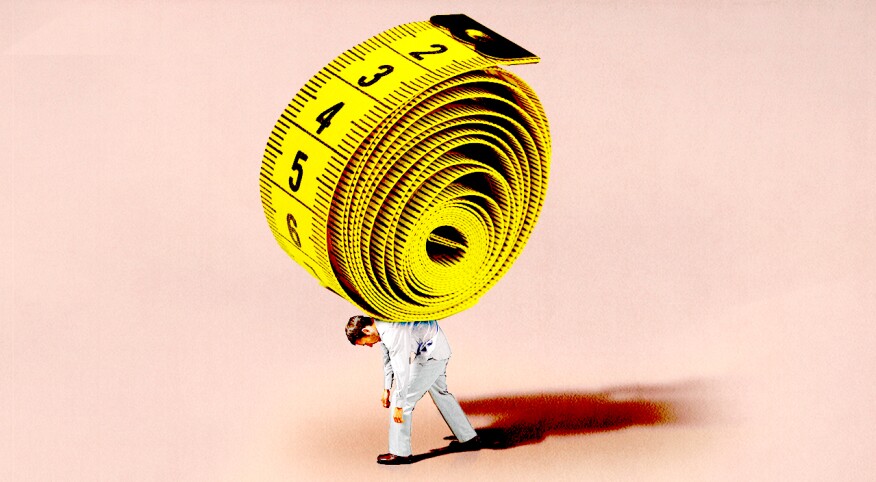As a health care practitioner, I’m all about functional medicine. That means I don’t focus on treating symptoms; instead, my goal is to find and treat the cause.
Sometimes, what seem to be separate problems are really just different manifestations of the same underlying issue. For example, two of the biggest complaints I hear from male patients are “My lower back hurts” and "Why is my gut so big?" These two issues may sound entirely unrelated, but usually they’re not. Weight gain and back pain are both manifestations of chronic inflammation. Quell that fire, and you’ll begin to look and feel leaner and healthier.
1. Tame inflammation with sleep
Fat, in particular the stubborn fat around your abdomen, is deeply intertwined with inflammation. Too much belly fat can trigger inflammation, but at the same time, inflammation can cause us to gain weight. Inflammation affects your hypothalamus, the part of your brain in charge of hunger signals. The more your belly grows, the more your brain fails to pick up on satiation signals — and the more you want to overeat. And here’s the thing: If your back pain isn’t caused by something mechanical, like a pulled muscle or pinched nerve, there’s a very good chance that it’s being caused by inflammation as well.
How do you quell inflammation? All the healthy stuff you already know: Eat more whole foods and fewer processed foods, and cut down on sugar and alcohol. But also: Get more sleep, at least 7 hours each night. A chronic lack of sleep can negatively impact immune cells, which can crank up inflammation.
2. Eat more pro- and prebiotic-rich foods
You’ve probably heard about your gut microbiome, the collection of bacteria and other organisms in your stomach that controls everything from immunity to your weight. When the bad strains of bacteria outnumber the good (also known as bacterial dysbiosis), it can trigger the same metabolic changes that occur with obesity and diabetes. What’s more, research has found a direct correlation between back pain and dysbiosis.
Keep your microbiome thriving by eating more foods high in probiotics, like sauerkraut, yogurt and kimchi. And don’t skimp on prebiotic fiber, which you can get from bananas, apples, whole oats and greens. They’re like a meal for your good gut bugs to help them multiply.
3. Uncover any food intolerances
Everyone's biochemistry is unique. There is no one size fits all when it comes to a healthy diet. To find out what you should actually be eating to feel stronger and lose belly fat, you need to find out if you have any food sensitivities. Eliminate the stuff that triggers inflammation, and you'll be on your way to a healthier gut and less back pain.
I recommend doing an elimination diet, the gold standard for discovering which foods are not working for you. Ideally, talk with a health professional about setting up a plan. You simply cut out an individual food you think might be triggering gut trouble for two to three weeks, and look to see if you feel less bloated and less back pain. Dairy (lactose) and wheat (gluten) are among the most common triggers.
4. Take a yoga class
Many forms of exercise, from running to weight lifting, can aggravate existing back issues. But you still need to work out. I recommend men try yoga, which is good for both your body and your mind. It gives you increased flexibility, which the National Institutes of Health has shown can ease moderate to severe chronic low back pain. It has also been shown to lower markers of inflammation in blood tests.
Yoga can also be incredibly beneficial for calming your mind and helping facilitate a better gut-feelings connection. What’s that? Read on.
5. Restore your gut-feelings connection
The mind-body connection (the link between your physical and emotional health) is often ignored in mainstream medicine. But a 2020 review of literature found 26 separate studies linking gut health to depression. You get depressed, your microbes get depressed — and vice versa.
Too much stress leads to higher inflammation, and that in turn can be a huge contributor to that pain in your lower back. I’ve seen it so often, I’ve even given it a name: shameflammation.
The solution comes down to restoring your gut feelings. That’s right, your belly has emotions too. And it needs more than a hug. To give it the emotional support it deserves, we need to focus on foods our gut loves, and practice a little self-compassion. As studies have demonstrated, when we’re kinder to ourselves, it lowers stress, which in turn lowers inflammation.
Stop beating yourself up about your diet, and your gut will take the cue and do the same. Think of yourself as your belly’s emotional mentor.

Paul Spella




